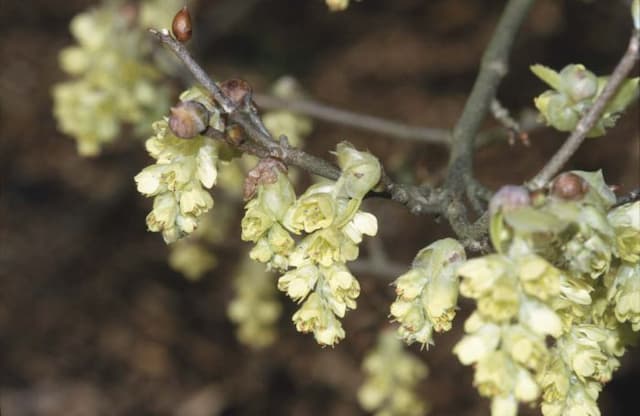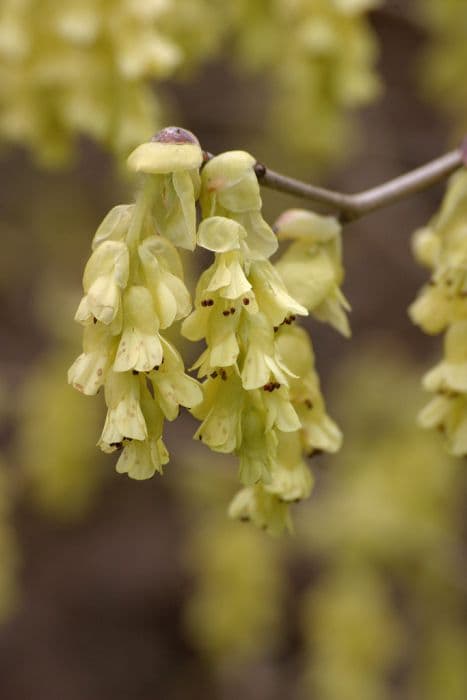Dwarf Fothergilla Fothergilla gardenii 'Blue Mist'

ABOUT
Fothergilla gardenii 'Blue Mist', commonly referred to as dwarf fothergilla, is a deciduous shrub known for its multi-season interest and charm. Its name 'Blue Mist' hints at the distinct blue-green foliage that makes an appearance in the spring. The leaves are elliptical to oblong and exhibit a fine texture that dances in the breeze. As the seasons progress, so does the color palette of the leaves, with their hues transitioning to a magnificent display of oranges, reds, and yellows in the fall, creating a brilliant autumnal spectacle. Before the leaves emerge, in spring, the dwarf fothergilla boasts bottlebrush-like flowers. These are spikes of creamy white flowers, which are particularly eye-catching and possess a honey-like fragrance that can add a delightful scent to any garden. The overall form of the dwarf fothergilla is rounded and bushy, with multiple stems rising from the base. Its branches give it a dense, full appearance that can provide texture and contrast within a garden setting. The texture and color of the foliage, combined with the striking flowers and seasonal color changes, make 'Blue Mist' dwarf fothergilla a lovely ornamental choice for gardeners looking to add year-round interest to their landscapes.
About this plant
 Names
NamesFamily
Hamamelidaceae.
Synonyms
Dwarf Fothergilla, Dwarf Witch Alder, Blue Mist Fothergilla.
Common names
Fothergilla gardenii 'Blue Mist'.
 Characteristics
CharacteristicsLife cycle
Perennials
Foliage type
Deciduous
Color of leaves
Mixed
Flower color
White
Height
2-3 feet (0.6-0.9 meters)
Spread
2-3 feet (0.6-0.9 meters)
Plant type
Shrub
Hardiness zones
5
Native area
Southeastern United States
Benefits
 General Benefits
General Benefits- Attractive Foliage: It produces striking blue-green leaves that add a unique color texture to the garden.
- Seasonal Interest: The plant has white, bottlebrush-like flowers in spring and exhibits beautiful fall foliage colors.
- Compact Size: 'Blue Mist' is a dwarf variety, making it suitable for small gardens or spaces.
- Low Maintenance: It requires minimal pruning and is generally easy to care for once established.
- Drought Tolerant: Once established, it is quite drought-resistant, requiring only occasional watering.
- Deer Resistant: Fothergilla is not a preferred plant for deer, which helps to prevent browsing damage in the garden.
- Pollinator Friendly: The flowers are attractive to bees and other pollinators, helping to support local ecosystems.
- Versatile: This plant can be used in mixed borders, foundation plantings, or as a specimen plant.
- Non-Invasive: It is not known for being aggressive or invasive, making it a good neighbor to other plants.
 Medical Properties
Medical PropertiesThis plant is not used for medical purposes.
 Air-purifying Qualities
Air-purifying QualitiesThis plant is not specifically known for air purifying qualities.
 Other Uses
Other Uses- Fothergilla gardenii 'Blue Mist', commonly known as dwarf fothergilla, can be used in miniature garden settings due to its compact size, adding a unique texture and color with its bluish foliage.
- Dwarf fothergilla makes an excellent choice for bonsai enthusiasts who want to work with a North American native species that offers interesting foliage and flowers.
- The plant's dense branches make it suitable for creating private garden spaces or living dividers in small urban gardens.
- Because of its resistance to deer browsing, dwarf fothergilla can be strategically planted in gardens to protect more vulnerable plants from deer damage.
- The aromatic flowers of dwarf fothergilla can be used to naturally scent your garden during blooming season, without the need for artificial fragrances.
- The contrast between its leaves and the striking, white, bottlebrush-like flowers provide an aesthetically appealing backdrop for photography and outdoor artwork displays.
- Dwarf fothergilla can be employed as a tactile plant in sensory gardens due to the texture of its leaves, which change throughout the seasons.
- Incorporate dwarf fothergilla into a wildlife-friendly landscape to attract a variety of pollinators, such as bees and butterflies, with its springtime flowers.
- The fall foliage color of this plant can be used in educational settings to help teach children or students about seasonal changes and plant biology.
- Dwarf fothergilla's dried flowers and leaves can be used in crafting for making natural wreaths and floral arrangements for autumn decoration.
Interesting Facts
 Feng Shui
Feng ShuiThe Fothergilla is not used in Feng Shui practice.
 Zodiac Sign Compitability
Zodiac Sign CompitabilityThe Fothergilla is not used in astrology practice.
 Plant Symbolism
Plant Symbolism- Adaptability: Fothergilla gardenii 'Blue Mist', commonly known as Dwarf Fothergilla, often symbolizes adaptability due to its ability to thrive in various soil conditions and partial shade to full sun.
- Resilience: Dwarf Fothergilla symbolizes resilience as it is a hardy plant that can withstand cold temperatures and is generally disease-resistant.
- Natural Beauty: The plant's striking blue-green foliage and honey-scented, bottlebrush-like flowers represent natural beauty and appreciation for the simple elegance of nature.
- Change and Renewal: As Dwarf Fothergilla exhibits stunning fall color changes, it often represents change and renewal, reminding us of life's constant evolution and cycles.
 Water
WaterFor the Dwarf Fothergilla, water the plant thoroughly to ensure the soil is moist but not waterlogged. During the first growing season, water the plant deeply once a week, allowing the soil to dry out slightly between waterings. Once established, the Dwarf Fothergilla is quite drought-tolerant but will appreciate additional water during prolonged dry spells. On average, providing about 1 gallon of water per week should be sufficient, adjusting for rain, temperature, and soil conditions.
 Light
LightDwarf Fothergilla thrives best in full sun to partial shade. It should be planted in a spot that receives at least 4 to 6 hours of direct sunlight per day, although it can also tolerate light dappled shade. Avoid deep shade conditions as they can lead to poor flowering and less vibrant fall foliage colors.
 Temperature
TemperatureDwarf Fothergilla performs well in a range of temperatures but prefers a temperate climate. It can typically withstand winter temperatures down to about -10°F and is suitable up to about 100°F during the summer months. The ideal temperature for this plant to flourish is between 60°F and 80°F.
 Pruning
PruningPrune Dwarf Fothergilla after it finishes flowering to maintain its shape and encourage healthy growth. Light pruning can be done to remove any dead or broken branches and to shape the plant. Pruning is typically done annually, with the best time being in late spring or early summer, after the bloom period.
 Cleaning
CleaningAs needed
 Soil
SoilDwarf Fothergilla requires an acidic soil mix with a pH of 5.0 to 6.0. A mix that includes peat, coarse sand, and pine bark will ensure good drainage and aeration. Amending with organic matter like compost also helps to retain moisture and nutrients.
 Repotting
RepottingDwarf Fothergilla does not need frequent repotting; it is typically repotted every 3-5 years. If growth is slow or roots become crowded, then repotting may be necessary. Early spring is the best time for repotting.
 Humidity & Misting
Humidity & MistingDwarf Fothergilla thrives in moderate humidity levels but is quite adaptable. It does not require any special humidity adjustments when planted in the ground in an outdoor environment.
 Suitable locations
Suitable locationsIndoor
Grow in bright, indirect light with moist, acidic soil.
Outdoor
Plant in partial shade, moist acidic soil, protect from harsh winds.
Hardiness zone
5-9 USDA
 Life cycle
Life cycleFothergilla gardenii 'Blue Mist', also known as Dwarf Fothergilla, begins its life cycle as a seed, which, when conditions are right—typically in spring—will germinate in moist, well-drained soil. Once the seedling emerges, it enters a period of vegetative growth, developing a woody stem and foliage that is unique for its blue-green color in this cultivar. Over time, the shrub matures and reaches its flowering stage, typically in late spring, producing distinctive brush-like white flowers that emit a sweet fragrance. Following pollination, often by bees and other insects, the flowers develop into seed capsules, which, when mature, release their seeds to potentially generate new plants. Dwarf Fothergilla undergoes a period of dormancy in the winter, shedding its leaves after they turn a striking range of yellows, oranges, and reds in the fall. This perennial shrub's life cycle then restarts in the spring when new buds break dormancy and the cycle of growth begins anew.
 Propogation
PropogationPropogation time
Spring to Summer
The Fothergilla gardenii 'Blue Mist', commonly known as Dwarf Fothergilla, is most frequently propagated by softwood cuttings taken in late spring to early summer. This method involves selecting healthy, non-flowering shoots and cutting a 4 to 6 inch (about 10 to 15 cm) portion from the tip. The cut should be made just below a node, and the bottom leaves are usually removed. A rooting hormone is often applied to the cut end to increase the chances of successful rooting. The cuttings are then placed in a well-draining soil mix and kept in a humid environment with plenty of indirect sunlight. After several weeks, once the cuttings have rooted, they can be transferred to individual pots to grow on before being planted out in the garden.









